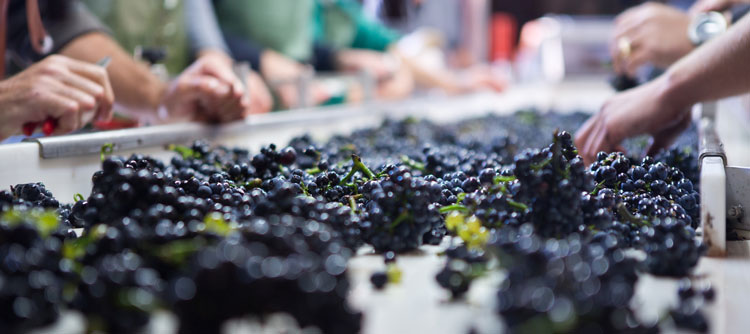To stay up-to-date with the BIVB, subscribe to news alerts
 Vintages
Vintages10/10/2023

The secateurs have been packed away and the cellar doors have closed after a harvest that began in the scorching heat at the end of August and ended more comfortably, with milder temperatures at the end of the summer. To everyone’s delight, the harvest was a good one, both in terms of quality and quantity, particularly for the Chardonnay. The Pinot Noir grapes are not to be outdone: large volumes meant they could be sorted for quality, allowing us to keep the best of a bumper year.
On Friday, August 25, the first snip of the secateurs marked the start of the harvest in the south of the region, in the Crémant de Bourgogne plots. Temperatures at the time were over 35°C in the sunshine, which lasted until the end of the first week of September.
Picking for the still wines came next, at the beginning of September. Because of the high temperatures, some winegrowers and cooperatives preferred to pick at night, while others shifted their harvesting times to just before sunrise.
Although affected by a lack of water, which has persisted since the 2022 vintage, the 2023 harvest is shaping up to be a generous one: stormy showers came at just the right time throughout the summer. The sunshine concentrated the sugar in the grape berries and enriched them with flavour and colour.
A gentle start to the cycle
Despite a milder winter than usual, budburst was a few days later than average, due to unstable weather until April (with rapidly alternating warmer and cooler-than-normal days). This slight delay meant they dodged the rare spring frosts.
The very first green tips were observed on April 2 on Chardonnay vines in early areas, then on Pinot Noir and Gamay vines on April 12.
As soon as budburst began, many plots showed a degree of variation, which lasted until the harvest. This is due to a staggered regrowth of the vines after the excellent 2022 harvest.
A rollercoaster spring, but a fine crop of emerging grape bunches
At the start of May, conditions became favourable for growth. The phenological stages followed on, one after another, at a frenetic pace. As the days went by, the leaves unfurled, finally giving the landscape its verdant hue, typical of the season.
From May 20 onwards, temperatures rose and remained above the seasonal norm, encouraging rapid progress towards flowering. The very first flowers appeared at the end of May. The mid-flowering stage followed on June 7, heralding a harvest for early September.
On the whole, the flowers came into bloom in excellent conditions, with favourable temperatures and plenty of sunshine.
Localised thunderstorms provided water at the very end of flowering, allowing the flower caps to fall off and encouraging wind pollination. The emergence of generous bunches of grapes reassured winegrowers of the coming harvest’s potential.
The spring ended with a water deficit which didn’t hold back the campaign at all, notwithstanding thunderstorms in June which brought some very heavy rainfall (in the Côte d'Or in particular, with 80 mm to 140 mm at a time).
A summer cocktail of all kinds of weather!
July, like June, was relatively unstable, with alternating thunderstorms, temperature peaks of up to 35-36°C and high humidity. This kind of volatility is conducive to disease, and winegrowers remained vigilant throughout the summer. Two hailstorms on July 11 and July 15 caused very localised damage (south of Mâconnais, north of Côte Chalonnaise, Meursault, and around Dijon). However, Bourgogne was generally unscathed, as could be seen by the vineyards of Chablis and Grand Auxerrois.
In early-ripening areas, the first grapes in the veraison stage - when they begin to change colour - were observed between July 11 and July 18, depending on the sector.
Temperatures remained relatively mild, with a fairly wide day/night range, which was very beneficial to the vines.
A hot harvest
The grapes ripened in warm, sunny conditions, allowing a steady build-up of sugar. August, punctuated by rainy spells, enabled the harvest capacity to be maintained, before ending with unseasonably high temperatures and sunshine.
For this reason, many winegrowers decide to pick at night or in the early hours of the morning. This preserves the freshness of the grapes and the quality of the vintage.
Harvesting began with the Crémant de Bourgogne from the Mâconnais (Lugny) on August 25, quickly followed by the rest of Bourgogne. The still white wines were harvested first, in the following week, particularly in early-ripening plots. Then the Pinot Noir grapes were picked, around the second week of September. The plentiful and beautiful bunches were able to take advantage of the late summer sunshine to perfect their ripeness.
The harvest moved upwards from the south to the north of Bourgogne, finishing at the end of September in Chablis and the Hautes Côtes.
The Chardonnay and Aligoté grapes were magnificent. More attention was paid to the Pinot Noir bunches, which are more sensitive to heat. They needed to be carefully sorted both in the vineyard and before going into the cellar to remove any scorched or shrivelled berries and keep only the best.
Once the cellar doors were closed, the vinification process began. A first glimpse of this vintage will be available at the Hospices de Beaune Wine Auction on November 19, when journalists and those in the wine industry will be able to taste the first samples of this vintage and look ahead to what's to come!
Contact:
Cécile Mathiaud – Head of PR at the BIVB
Phone: +33 (0)6 08 56 85 56 – cecile.mathiaud@bivb.com